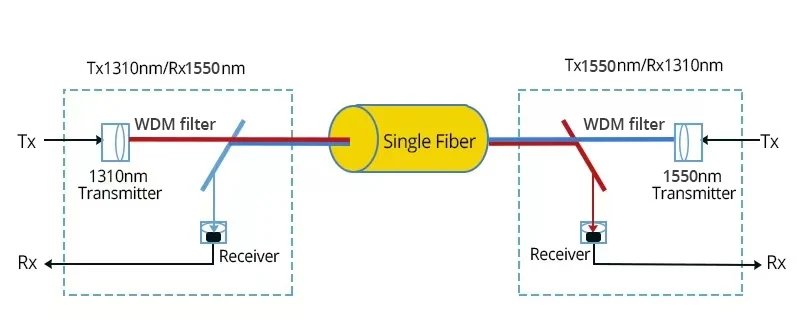

 Knowledge Base +
Knowledge Base +  2024.01.09
2024.01.09BiDi SFP means bidirectional small form-factor pluggable transceiver. The most distinct characteristic of the bidirectional SFP transceiver is that it is able to achieve bidirectional fiber optic communication by operating on a single fiber. Based on WDM (Wavelength-Division Multiplexing) technology, BiDi optics are able to split different wavelengths of light paths through an integrated wavelength-division multiplexing splitter of BiDi SFP transceivers. The following is a Cisco BiDi SFP provided by Walsun.
How Does BiDi SFP Work?
As the above-mentioned introduction about BiDi SFP, we have learned the modules separate different transmission wavelengths over a single fiber to achieve optical communication. To elaborate, the single-fiber bidirectional SFP transceivers must be used in pairs, as depicted in figure 2. At one side a 1000BASE-BX10-U (Tx1310nm/Rx1490nm) BiDi SFP transceiver transmit a 1310nm wavelength optical signal and receive a 1490nm optical signal while the opposite side of the single-fiber bidirectional link 1000BASE-BX10-D (Tx1490nm/Rx1310nm) BiDi SFP transmit a wavelength of 1490nm and receive a 1310nm optical signal conversely. The integrated optical component of WDM couplers plays a critical role in bidirectional fiber optic communication.

Advantages and Limitations of Bidi SFP Technology
Bidi SFP (Small Form-factor Pluggable) technology, also known as bidirectional SFP, is a type of optical transceiver that allows for bidirectional communication over a single fiber optic cable. It utilizes wavelength division multiplexing (WDM) technology to transmit and receive data simultaneously on different wavelengths.
How does bidi SFP work? Bidi SFP modules contain two optical transceivers, each operating on a different wavelength. One transceiver operates on a downstream wavelength, while the other operates on an upstream wavelength. These two wavelengths are combined and transmitted over a single fiber optic cable. At the other end of the cable, the wavelengths are separated and received by the respective transceivers.
The advantages of bidi SFP technology are:
1. Cost-effective: Bidi SFP modules eliminate the need for two separate fibers for bidirectional communication, reducing the cost of fiber optic infrastructure.
2. Increased capacity: By utilizing different wavelengths, bidi SFP allows for simultaneous bidirectional communication, effectively doubling the capacity of a single fiber.
3. Simplified installation: Bidi SFP modules are hot-swappable and can be easily installed or replaced without disrupting the network.
However, bidi SFP technology also has its limitations:
1. Limited distance: Bidi SFP modules typically have a shorter transmission distance compared to traditional SFP modules. This is due to the complexity of combining and separating wavelengths, which can result in higher signal loss.
2. Compatibility: Bidi SFP modules require matching pairs at each end of the fiber optic link. This can limit interoperability with other types of SFP modules.
3. Upgradability: Bidi SFP modules may not be easily upgradable to higher data rates or newer technologies, as they are designed for specific wavelengths.
In the latest point of view, bidi SFP technology continues to be widely used in various applications where cost-effective bidirectional communication is required over limited distances. However, advancements in fiber optic technology, such as the development of higher-capacity single-mode fibers and more efficient wavelength division multiplexing techniques, may offer alternative solutions that overcome some of the limitations of bidi SFP technology.
Subscribe to the newsletter
for all the latest updates.
2-5# Building, Tongfuyu Industrial Zone, Aiqun Road, Shiyan Street, Baoan District, Shenzhen. China
